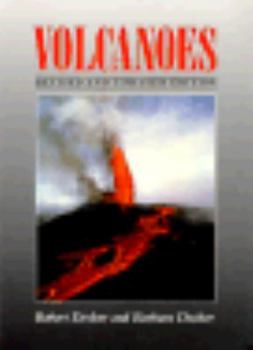Volcanoes
The most affordable, informative text available on the intricate anatomy of volcanoes, this concise paperback is the ideal text for classes in geology, atmospheric science and geography. Beautifully... This description may be from another edition of this product.
Format:Paperback
Language:English
ISBN:0716718510
ISBN13:9780716718512
Release Date:January 1989
Publisher:W.H. Freeman & Company
Length:285 Pages
Weight:1.05 lbs.
Dimensions:0.6" x 9.0" x 9.0"
Customer Reviews
5 ratings
Understanding volcanoes
Published by Thriftbooks.com User , 22 years ago
I hardly ever read a college text straight through, but this book was so informative and lucidly written, I could scarcely put it down. I imagine "Volcanoes" is used as a freshman introductory course, as there is very little geological mumbo-jumbo about say, the differences between a reverse dip slip fault and a left lateral strike slip fault.In fact, I wish I'd read this book first, before "The Encyclopedia of Earthquakes and Volcanoes" or "Perils of a Restless Planet." Its definitions are clear and easy to remember, and usually accompanied by a photograph or drawing. One of my favorites is a photograph of the San Andreas fault, which is a right lateral fault, "so called because for a person standing on either plate, the sense of motion on the opposite side is to the right."Now, at least I understand the difference between left and right lateral faults. Dip slips and strike slips will have to wait for another book for geometrically-challenged folks like me---I can't just close my eyes and visualize a three dimensional object, unless prompted by very clear diagrams and text.This book is an introduction to the geology of volcanoes (plate tectonics, the formation of mineral deposits, etc.), rather than a series of stories about dangerous volcanoes, although there is an appendix on "The World's 101 Most Notorious Volcanoes." One of my favorite chapters, "Volcanic Power" has little to do with volcanoes as we usually picture them, e.g. an erupting strato-volcano like Mt. Vesuvius. It is about geothermal energy, and why it might play an important role in our future:"Even though geothermal power is still an infant and largely unproved industry, its potential makes it worth serious effort and investment. The U.S. Geological Survey in a recent assessment of potential geothermal energy resources in the fifty states to depths of 10 kilometers listed the following estimates: hydrothermal reservoirs, 12 x 10(to the 21st power) joules, or about 2 times the energy in the world's oil reserves; hot dry rock, 32 x 10(to the 24th power) joules, or about 6000 times the energy in the world's oil reserves; magma reservoirs, 4 x 10(to the 23rd power) joules, or about 80 times the energy in the world's oil reserves."In light of recent history, perhaps we should be investing more research in our geothermal resources.Read "Volcanoes" if you have any interest at all in geology. It would even make a good high school text, although it is a bit dated: my copy was published in 1981, but the only thing that struck me as out-of-date was a diagram of the Earth's crustal plates---the Juan de Fuca plate was labeled `Gorda Plate,' although everything was pretty much in the right place. Just be sure to buy the revised and expanded version that was published in 1989.
Outstanding blend of readability and rigor
Published by Thriftbooks.com User , 23 years ago
This book presents fascinating yet complex information with commendable clarity. Not only is the writing excellent, but the diagrams add much to the exposition. For example, the diagram on page 88 ("Ring of Fire" chapter) clearly explains the relationship between severity of volcanism and earthquakes to the steepness of the angle at which a tectonic plate is subducted into the mantle. The book is sensibly organized into introductory material, chapters giving "autobiographies" of volcanoes and thus clarifying the multiplicity of volcanic and eruption types, chapters synthesizing this knowledge into generalization, and chapters explaining opportunities and risks associated with vulcanism (eruption dangers [carefully subdivided into discussion of nuées ardentes, lahars, and lava flows] potential of climatic change, likelihood of finding valuable ores, and the potential of geothermal power). Twenty-five superb color plates, in addition to the excellent diagrams, grace the book. Useful appendices include "World's 101 Most Notorious Volcanoes," web sites pertinent to volcanology, and a useful glossary (although the Icelandic term jökulhlaup [= "glacier outburst flood possibly triggered by volcanism"] is an omission I noted).This book deserves the rare commendation of simultaneous suitability for a rigorous introductory course in volcanology and accessibility to the curious layperson with no formal geological training, such as myself.
impressed by the content
Published by Thriftbooks.com User , 24 years ago
I was very pleased to read this book. It gives excellent documentation of various aspects in relation to volcanos. My hat goes off to Robert and Barbara Decker.
It's cool. I want to become a volcanologist.
Published by Thriftbooks.com User , 25 years ago
I love Volcanoes and most of the books made about it I would give it A two thumbs up
Excellent overview of volcanoes well worth reading.
Published by Thriftbooks.com User , 25 years ago
I really found this book invaliable in my first year of university, especially as volcanoes are my passion. I would recommend this book to anyone with an intrest in all things to do with volcanoes without the hassle of a geological textbook. It covers the main points well and also looks at the impacts upon people who lives near them. The section on volcanic dangers is thought provoking and I found the disscussion and the intergration of diagrams very well done. Very easy to understand.





